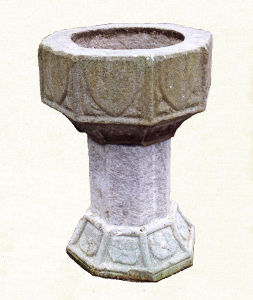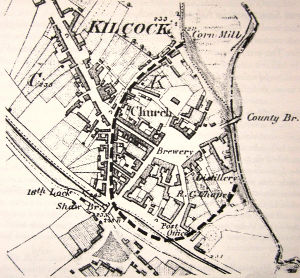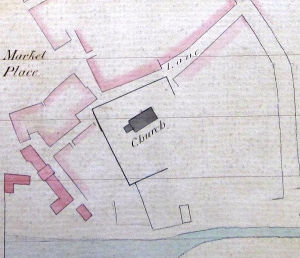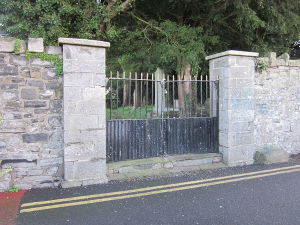Kilcock, from St. Coca to the Reformation
A history of Christianity in Kilcock between AD 550 and 1550
This work is a slightly modified version of the article first published in Unity in Division, 1999.
The civil parish of Kilcock has an area of 4,058 statute acres and consists of the following townlands: Boycetown, Branganstown, Clonsast, Courtown Great, Courtown Little, Duncreevan, Graigadder, Hodgestown, Kilcock, Laragh, Laragh Demesne, Newtownlaragh, Portgloriam and Rosetown. There are also three townlands named Commons surrounding Kilcock Town: Commons East, Commons South and Commons West.1 Other placenames that survive within some townlands and are mentioned in church records include, The Mount in Portgloriam, Castlerag a southern section of Kilcock townland, Whitestown in the eastern Boycetown, Bawnog in Commons West and Cross Keys in Hodgestown and part of Portgloriam.
The earliest documentary reference relating to Kilcock comes from the Annals and relates to an event in AD 774 when there was a battle at Cill-Coca on the boundary of the Kingdoms of Meath and Leinster.2 This placename includes an ecclesiastical element indicating the nature of the site and also giving the name of the patroness and founding saint. Kilcock (Cill Coca) when translated refers to ‘the Church of Coca’.3
St. Coca
Various writers have suggested that there were four different saints from the early Christian period who could have been the St. Coca associated with Kilcock.4
Firstly, St. Cocha, abbess of Ros-Bennchuir in Co. Clare. She lived in the early fifth century and was probably born on the Island of Cape Clear in Co. Cork.5 In the early period of her life she had been the nurse and guardian of St. Kieran of Saigir. She later founded the monastery of Ros-Bennchuir and presided over the education of noble virgins who were entrusted to her. Her feast day occurs on the 29th of June.6 Because of the distance between West Munster and North Leinster it is unlikely that she was the St. Coca associated with Kilcock.
A second saint known as Coca and also as Ernact was, according to at least one writer, commemorated on the 6th of June.7 It would appear Ernact may have been a separate saint whose feast day was celebrated on the 8th of January, a date also associated with Coca. She was a virgin saint who was noted for making and repairing Church vestments.8 It has also been suggested she was St. Columkills embroiderer.9 St. Ernact was associated with Duneane in Co. Antrim and was buried at Tamlacth in Co. Armagh.10
The third saint was known as Coiningean and Cuach. She lived in the 6th century and was associated with the Church of Fionnmugh and also Killeencormack where it is thought she was buried.11 Some accounts suggest that she was the sister of a number of early Christian saints including St. Kevin of Glendalough.12 She was the pupil of Bishop Mac Tail of Kilcullen and it appears that there was some form of conflict between them. However, the contents of the dispute do not survive. It is known the clergy of Leinster took her side and denounced Mac Tail.13 This event must have occurred before 549 as Mac Tail died in that year.14 The feast of St. Coiningean was celebrated on the 29th of April and she was also commemorated on this day in Scotland.15
The fourth saint St. Coca was named Cuach and she may be one and the same with the previously mentioned saint although her feast day occurs on the 8th of January.16 She is referred to in many writings as Cuach virgin of Cill-Cuaigh in Caibre na Ciardha (sub-kingdom of Carbury).17 Yhis Cill-Cuaigh has been identified as Kilcock due to the close proximity of Carbury to Kilcock. However, there may be some doubt of this as the sub-kingdom of Carbury did not extend east of Johnstownbridge. Furthermore Carbury in the early Christian period was situated in the Kingdom of Meath while Kilcock was situated in Leinster.18 A site in Carbury barony, probably Kilcooney Church in Collinstown townland, may also be a possible location of this establishment.19
However, not withstanding the above the ancient calendar of Irish Saints written in 1630 listed a St. Coca with a feast day of the 6th of June. Unlike other saints thought to be St. Coca there are no other details given. She was the only saint with the correct spelling of Coca.20 It is possible she was St. Cuach of Carbury who may have a second feast day on the 6th of June. Alternatively, she could have been a local missionary with no further details surviving except the placename Cill Coca.
The St. Coca foundation at Kilcock appears to have been a nunnery and subsequently a small Christian community emerged.21
The local tradition in Kilcock through the centuries gives the 6th of June as the feast day of St. Coca. Ancient writings suggest there is a Cill Coca in the province of Meath one days journey from Dublin where the name and feast of St. Coca, a virgin, is celebrated on the 6th of June.22 This is certainly Kilcock given the locality’s close proximity to Meath. The immediate area of Kilcock in the 6th century may have been easier to reach from the Kingdom of Meath. Writings from the medieval period suggest there was an extensive area of forest south of the Rye-water river.23
It is also known there was a crossing of the river at Kilcock linking Meath with Leinster in the early Christian period.24 So the topography of the area at this early period would point to much easier access to Kilcock from Meath and this may explain why early writers described Kilcock as being situated in the province of Meath.
Early Christian Ecclesiastical Foundation
Archaeological research on early Christian ecclesiastical centres show that there was an enclosure surrounding most Churches and furthermore there may have been an outer enclosure surrounding this inner enclosure. Sometimes there was also a holy well or bullaun stone close by.25 Kilcock may have evidence suggesting the existence of the three features described.
St. Coca’s graveyard in Kilcock is on the site of the early Christian foundation. Ancient graveyards that are circular or oval in shape and have an approximate internal measurement of 50 metres in diameter usually date from the early Christian period. St. Coca’s graveyard is near circular and has similar internal measurements. It is unlikely that there were stone Churches built on sites like Kilcock at this early period, almost all the Churches were built of wood. The outer-enclosure is usually circular or oval in shape and evidence of these boundaries may have survived in towns and built up areas in the form of a circular street system surrounding the ancient Church and graveyard.26 On examining a map of Kilcock town it is obvious there is a near circular road system surrounding St. Cocas graveyard. This semi-circular series of streets extends from Mill Lane to Greenwell Lane and is apparently on the boundary of the outer-enclosure with the Rye-water river serving as the eastern boundary. The approximate area of this enclosure is 14 acres and this measurement is not unusual in comparison with other early Christian enclosures.27
The site of a holy well dedicated to St. Coca is situated in the north east area of the outer enclosure.28 This may well have been a focus of pre-Christian worship and could have had a major bearing on the choice of the site by St. Coca and fellow Christian missionaries.29 It was, until its destruction in the 19th century, the sole remaining relic of the early Christian establishment.
Norman Period
Very little documentary information survives from the Kilcock area before the immediate Norman period. Kilcock Church together with other churches in the area underwent considerable ecclesiastical transition following the Norman Conquest. By 1220 almost all Churches in the area had clerics of Norman or English origin.30 The Normans accelerated the evolution from the original monastic system to parish organisation and the parish evolved with more or less the same area as the newly established Manors. In this way the manor of Kilcock was probably based on an earlier Celtic ecclesiastical area and eventually evolved into the medieval parish now represented by the civil parish.31 The original Norman lords of the area, John de Hereford and his son Thomas, granted many churches under their control to the Knights Hospitallers religious order at this time and it is likely Kilcock church was also granted at this time.32
Kinghts Hospitallers
The Knights of St. John of Jerusalem otherwise known as the Knights Hospitallers were a semi-military, semi-religious order. Their chief house in Ireland was at Kilmainham which was under the control of a head prior. He would have supplied clerics to churches under his control including Kilcock and income from the parish was also paid to him.33 Details of ecclesiastical revenue from Kilcock in 1303 survive. The hospitallers were named rectors and the vicarage was valued at 42 shillings (£2.10).34
Medieval Church
It is likely the first Norman Church in Kilcock was built of stone. The church which survived in St. Coca’s graveyard until the early 1870’s was likely to have been medieval and may well have been the church mentioned in 1303. It was an extensive church capable of seating 90 people.35 The outline of this church is clearly visible in the graveyard at the present time and has an approximate area of 60′ × 15′. This area is similar to other Hospitaller Churches in the locality such as Balraheen and Mainham. A substantial portion of Mainham Church survives and has been dated to the late medieval period.36 Given that the churches of Kilcock and Mainham date from the same period and have similar dimensions it is likely they were also of similar appearance.
Although only the outline of Kilcock medieval Church survives overground, a well preserved underground vault has also survived. This may also date from the late medieval period and one of the functions of the underground chamber could be its use for burials.
Market Cross
It is likely the medieval town of Kilcock was laid out within the ecclesiastical enclosure and was based on the village green plan with the medieval church and inner enclosure safely within any town defences that may have existed.37
An important feature within most medieval towns was the market cross which was usually sited on the market area commonly known as the ‘Green’. The original market cross of Kilcock would have been sited in the centre of the market place now known as the ‘Square’. Ecclesiastical announcements, decrees and civil proclamations were read at this spot. The base of the recently identified Kilcock market cross38 may date to the late medieval period and could be a replacement for an earlier one. It is probable that in the late medieval period the market cross was moved from the market place to the Fair Green which at that period had developed as the principal market site in the town.
Medieval Sanctuary in Kilcock Church
An incident involving Kilcock Church in 1312 gives an account of how law offenders could seek sanctuary in medieval churches and therefore avoid arrest by the civil authorities. The following event is reported in the ‘Judiciary Ross’ as follows:
John Goddard feloniously slew Philip Benet servant of John de le Cornere, in the town of Kylkoc on Sunday after the nativity of St. John the Baptist, and immediately after the felony fled to the Church of Kylkoc and in the said Church acknowledged before the coroner that he had committed the said felony, wherefore the coroner put a guard over him and John Goddard kept himself in the Church from that day to the sixteenth day following them by fault of the guard he escaped.39
It is likely this John Goiddard came from Gragadder townsland which was formerly known as Goddards-Grange. The Church in question was the Knights Hospitaller church in St. Coca’s graveyard. It is interesting that the church in Kilcock as a place of refuge and safety was adhered to by both the Knight Hospitaller and the civil authorities during the 16 day stand-off despite the fact that Goddard had previously killed a man in 1307. It is not known what became of Goddard who was outlawed and had his property confiscated.40
Knights Hospitaller Lease of 1334
Very little information of clerics appointed to or associated with Kilcock in the middle ages survives. However, records of three leases involving Knights Hospitaller properties in Kilcock which survive from 1334 names one medieval cleric who may be associated with the parish. One of the properties was a ‘messuage’, which relates to a dwelling and a plot of land around it. It was previously in the possession of James Naueru and let to a cleric named Richard McColaghty. This cleric was to pay the Knights Hospitallers 3 solidos and 10 denarios annually and furthermore, provisions were provided in the lease that in the event of his death the property would then pass to his brother David.41 It is not known what religious duties, if any, Richard McColaghty had in relation to Kilcock, however, he may have been an assistant cleric as the leading cleric in parishes at that time would have had a dwelling supplied by the rectory and therefore would not have had to lease one. Furthermore, other parishes in the area at this period were known to have had two clergymen attached to them, with one referred to as a Priest and the other as a cleric.42
The second property let in this transaction had an area of 5 perches (pentrs) long by 3 perches wide and was let to Richard Wallensi for 15 denarios annually with succession rights to Richard’s brother John. The third property was a messuage previously in the possession of John Arden and let to Maurice son of Maurice de Duncreny. The revenue from the Kilcock properties was paid to John Outlaw, the head prior of the Knights Hospitallers in Kilmainham.43
Thomas Fitzgerald, Prior of Kilmainham
Between 1438 and 1447 Thomas Fitzgerald, grandson of Maurice 4th Earl of Kildare, was Prior of the Knights Hospitallers and responsible for the orders possessions which included Kilcock Church.44 This period in the 15th century saw many acts of lawlessness which on occasions even involved the prior of the Knights Hospitallers.

Baptismal font from the Medieval Church in Kilcock. This font predates the Reformation and is now in St. Marys, Church of Ireland Church, Maynooth.
In 1441 the Prior was implicated in the kidnapping of William de Wells, a brother of the Viceory. The deed was carried out by the Prior’s two brothers, William and James Fitzgerald. They ambushed a party which included William de Wells at Kilcock, killed several of the bodyguards and took de Wells prisoner. Certain demands were them made in order to obtain his release. The Viceroy, Sir Leon de Wells, suspected the Prior’s involvement and ordered him to present himself to the Council. The Prior refused to comply and the Crown seized all the Knights Hospitaller property with the exception of Kilmainham Priory. Prior Fitzgerald, however, had the proceedings annulled when he came to court and produced a Royal pardon. In the meantime the Viceroy’s brother was kept in a Fitzgerald dungeon until the kidnappers demands were obtained.45
Prior Fitzgerald’s controversial career came to an end in 1447 when he was deposed, for the misuse of the Hospitaller seal which he had affixed to many illegal grants.46
The Reformation in Kilcock
By the early 1500s the Knights Hospitallers, although declining in importance, still held a large number of parishes including Kilcock.47 At the time of the reformation most of the monasteries and religious orders were suppressed. The Knights Hospitallers were disbanded by order of King Henry VIII in 1540. The Prior of the Order, John Rawson, was granted a title and received a pension while the order’s assets, including property in Kilcock, were seized by the crown.48 A record of Hospitallers property and ecclesiastical income from Kilcock survives from an inquisition taken in 1544. This shows the rectory with 3 messuages and 5 acres of arable land with an annual value of £9–3–4 (£9.16).49 The property had been let out but the letting agreement was not affected as the payment of rent merely reverted from Prior Rawson to the Crown.
It was reported on a number of occasions at this time that the Vicars of Kilcock were absent from their parish. On the 20th of June 1543 and the 17th of April 1544 Thomas Rekeston, Vicar of Kilcock, was reported as an absentee. The reports were made to the Barons of the Exchequer in Dublin Castle who noted that the Vicar was worth £10 per Annum. It is not known subsequently whether he died or was relieved of his position for in 1546 John Birmingham had replaced him as Vicar of Kilcock. On the 14th of May of that year the new Vicar was also reported to the Barons of the Exchequer as absent from his parish. On the 27th of November 1548 the Bishop of Kildare, William Miagh, who had been a royal appointee to his position, reported that John Birmingham of Kilcock and other Vicars in the area do not reside. Although this probably indicates non residency in the parish, it could also suggest that the Kilcock clerics were indeed still active in the area and keeping a low profile. One possible reason for this would be an attempt to avoid taking the Oath of Supremacy which all clerics in the Pale were obliged to take. A further non residing accusation against John Birmingham was made on the 5th of May 1549 when he was also accused with a number of other vicars of not keeping school.50 This would relate to the non compliance of statute 28 of Henry VIII which was strictly enforced in the Pale and required clergymen to keep a school to teach the English language.
Although the possession of the parish church passed to the newly reformed Established Church the vast majority of Christians in Kilcock supported Papal authority and they continued to practice their religion discreetly in private houses and private chapels of the leading gentry. One ecclesiastical area which remained unaffected by the Reformation was the burial ground adjoining the church now St. Coca’s graveyard where internments from both sides of the religious divide continued without conflict or division.
Footnotes
- Official townland names as on all additions of the ordnance survey maps.
- John O’Donovan, The Annals of the Four Masters, Vol. I, (Dublin, 1848), pp 378–9.
- P.W. Joyce, Irish Placenames, Vol. III, (Dublin, 1995) p. 401.
- John O’Hanlon, Lives of the Irish Saints, Vol. XI, (Dublin, 1891), pp 212–3.
- Ibid. p. 822.
- John O’Donovan (ed.) with Irish texts by J.H. Todd and W. Reeves, The Martyrology of Donegal, A calendar of the Saints of Ireland, (Dublin, 1864), p. 183; also O’Hanlon, Lives of the Irish Saints, Vol. VI, p. 822.
- Joyce, Irish Placenames, p. 401.
- O’Hanlon, Lives of the Irish Saints, Vol.I, (Dublin, 1875), pp 124–6.
- Joyce, Irish Placenames, p. 401.
- O’Hanlon, Lives of the Irish Saints, Vol.I, p. 125.
- O’Hanlon, Lives of the Irish Saints, Vol.IV, (Dublin, 1886), p. 150. The site of Fionnmagh has not been located but it is thought to be close to Killeencormack which is situated 5 miles south-east of Kilcullen.
- Rev John Shearman, Loco Patricana, (Dublin, 1879), p. 150. Note 2 in this publication includes genealogy of this St. Cuach and indicates that she was the sister of St. Attrachta of Kilaraght of Co. Sligo and a half sister of St. Kevin of Glendalough.
- O’Donovan, Martyrology of Donegal, p. 113; O’Hanlon, Lives of the Irish Saints, Vol.VI, p. 620.
- T.W. Moody, F.X. Martin and F.J. Byrne, ‘A chronology of Irish History to 1976’ in A new History of Ireland Vol. XIII, (Oxford, 1982), p. 19.
- O’Hanlon, Lives of the Irish Saints, Vol.IV, p. 542.
- O’Hanlon, Lives of the Irish Saints, Vol.I, p.130.
- O’Donovan, Martyrology of Donegal, p. 11.
- Alfred P. Smyth, Celtic Leinster, (Dublin, 1982), pp 10,147
- For further details see Michael Comerford, Collections relating to the Diocese of Kildare and Leighlin Vol II, (Dublin, 1883, pp 95–6; According to Joyce in Irish Names of Places, p. 401, a placename named Kilcooney comes from Cill Coona.
- O’Donovan, Martyrology of Donegal, p. 147.
- O’Hanlon, Lives of the Irish Saints, Vo. VI, p. 215.
- O’Donovan, Martyrology of Donegal, p. 397.
- Smyth, Celtic Leinster, p. 45.
- O’Donovan, The Annals of the Four Masters, Vol. I, pp 378–9.
- Leo Swan, ’Early Ecclesiastical sites in Westmeath’, in John Bradley (ed.) Settlement and Society in Medieval Ireland, (Kilkenny, 1988), p. 4.
- F.H.A. Aalen, Kevin Whelan, Matthew Stout, (ed.) Atlas of the Irish Rural Landscape, (Cork, 1997), p. 50.
- All early Christian Church sites in Kilcock and Newtown parish have topographical evidence indicating the existence of outer-enclosures, the area of the Clonshanbo enclosure is 20 acres and the approximate area of Kildonnell in Grange is 4 acres.
- Comerford, Comerford Collections, Vol II, p. 155.
- Catherine O’Donoghue, ‘Holy Wells’ in Unity in Division, (Kilcock, 1999), pp 169–175; see also Patrick Logan, The Holy Wells of Ireland, (Buckinghamshire, 1980), p. 13.
- J.T. Gilbert (ed.) Register of the Abbey of St Thomas the Martyr, (London, 1998), pp 82, 365; includes lists of clerics of Norman origin in North Kildare.
- A.J. Ruthven, History of Medieval Ireland, (London, 1968), p. 126.
- Gustavus E. Hamilton, ‘The names of the Baronies and Parishes in Co Kildare’ in J.K.A.S. Vol. IX, p. 255.
- Archdeacon Sherlock, ‘Knights Hospitallers in Co Kildare’ in J.K.A.S. Vol VI, pp 89–95.
- H.S. Sweetman, Calendar of Documents relating to Ireland 1172–1307, (London, 1886), p. 246.
- Ecclesiastical Commissioners Report No 4 1837, Revenues and Patronage of Benefices, Diocese of Kildare, p. 123. RCB Library Dublin.
- Topographical Survey of Mainham, OPW, Dublin.
- For more on village green plan see, Trevor Rowley and John Wood, Deserted Villages, (Haverfordwest, 1995), pp 40, 43.
- The Iochtar stone from the Fair Green Kilcock confirmed as a cross-base by Thaddeus Breen, Archaeologist in July 1999.
- John Mills and M.C. Griffith (eds.) Calendar of Justiciary Rolls 1295–1314, (Dublin, 1965), p. 243; See also Martin J. Kelly, ‘Almost total Banishment in Conquest of Kildare’, an article in the Leinster Leader, 1970.
- Mills and Griffith, Justiciary Rolls, p. 243.
- Charles McNeill, Registram de Kilmainham, (Dublin, 1943), p. 49.
- Gilbert, Register of the Abbey of St Thomas the Martyr, pp 82, 189.
- McNeill, Registram de Kilmainham, pp. 49, 50.
- Lord Walter FitzGerald, ‘Thomas FitzGerald, Prior of Kilmainham 1438–1347’ in J.K.A.S. Vol.III, p. 334.
- Ibid pp 334–5.
- Ibid p. 336.
- Hamilton, Baronies and Parishes of Co Kildare, p. 255.
- Aubrey Gwynn and R. Neville Hadcock, Medieval Religious House in Ireland, (London, 1970), p. 333.
- Hamilton, Baronies and Parishes of Co Kildare, p. 255.
- Margaret C. Griffith (ed.), Calendar of Inquisitions Co Dublin, (Dublin, 1991), pp 101, 102.



